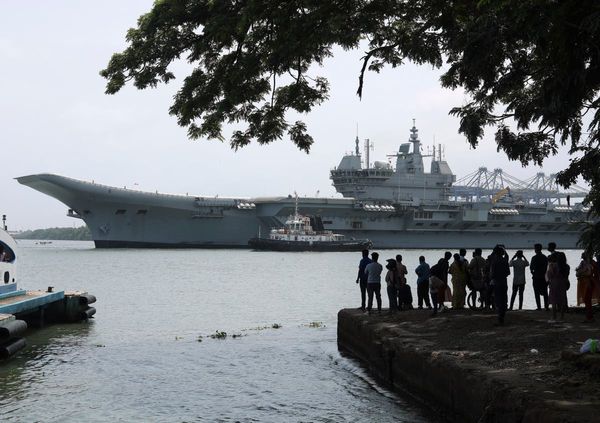UK defence minister Alex Chalk visited Rosyth shipyard in Fife, Scotland a few days ago to kick off construction on the second ship in a new class of frigates for the Royal Navy. The navy is buying five of these state-of-the-art Type 31 warships for active service by 2027.
Yet while Chalk talked up the “world-class facilities” at Rosyth and selling more of these ships to other countries in future, doubts are simultaneously being raised about the frigates due after the Type 31s. The Type 32 programme, due to start completions by the early 2030s, may be cancelled in the prime minister’s March defence review due to a lack of funds. This threatens the government’s whole strategy for increasing the navy.
Defence spending has broadly declined as a percentage of GDP since the end of the cold war, so overspends on one project often require savings elsewhere. The Type 32 programme follows a long line of projects going over budget, missing delivery dates or both.
Among the worst examples is the British Army’s Ajax programme for new armoured tanks. Originally aiming to procure 589 vehicles for £3.5 billion by 2017, the tanks have been beset by technical problems. Only 26 have been delivered and even they are not considered deployable due to noise and vibration problems.
Meanwhile, the two Queen Elizabeth-class aircraft carriers cost nearly double the original £3.9 billion estimate. Initially due in 2012, the first did not come into service until 2017, while the second was two years later. The budget for the navy’s Astute class of submarines also roughly doubled, while its six Type 45 destroyers cost 30% more than planned and were two years late.
Defence procurement is regularly reformed, but the same cost overruns and delays continue to occur. So what can be done?
Learning from the interwar era
The history of the UK aircraft industry between the first and second world wars is a useful comparison. Like today, the industry was wholly private (it was nationalised between the second world war and the 1980s). This meant the government’s military R&D and information on what was feasible was largely reliant on external contractors whose first priority was making a profit.
Also like today, the 1930s aircraft industry was attempting to use new technologies without knowing what was possible or how to do it. By contrast, there were far fewer technological changes to aircraft in, say, the 1950s or 1960s.
Manufacturers in the 1930s were having to rethink aircraft designs to include retractable undercarriages and new propellers, while mounting machine guns and cannons on wings for the first time. At the same time, they were moving from wooden to metal aircraft to allow greater airspeeds.
Firms were overconfident in what they said they could deliver. In the 1920s, they had told the Air Ministry that the move to metal aircraft would speed up manufacturing and lead to fewer delays, and yet delays got steadily worse in the 1930s. The ministry talked of adding at least six months to manufacturers’ estimates to make them realistic.
As rearmament took off in the 1930s, the government also changed many requirements. For instance, Supermarine S5s were racing aircraft that had to be modified over several years to become Spitfire fighter aircraft. All these things contributed to delays and cost overruns.
How it compares
Today, computer power continually pushes the boundaries of what is possible. Suppliers often don’t know whether a new technology will work and regularly over-promise – while the government is often unsure what it actually needs.
Projects often start with vague ambitions that become detailed during production, and spec changes are one major reason for delays and cost overruns. With the Queen Elizabeth-class aircraft carriers, for example, the take-off and landing mechanisms were changed on several occasions prior to full-scale production.
So what can interwar aircraft production tell us? Of course, they were unique times that required unique solutions, such as turning car plants into “shadow factories” for making more aircraft. But many of the policies introduced to get the air force ready for war could be applied again.
For example, the Air Ministry stated as early as 1925 that when new aircraft were being trialled, pilots should only highlight modifications required for safety and nothing more. Today’s planners could equally avoid big modifications or changes unless absolutely necessary.
Air Ministry procurement officials were often also kept in post for more than five years. Today it’s more like 18 months to two years. Make this longer and personnel would have to face the consequences of their decisions.
In the 1930s, budgets and accounting started being done on a multi-year basis. The RAF could then place orders over several years as opposed to one-year contracts, giving manufacturers greater certainty for hiring and training skilled labour and investing in additional capacity. This, too, could be done again.
Admittedly, there is a limit to what we can achieve. The tech issues show no signs of abating – and they’re a problem for all countries. This partly explains international collaboration in defence procurement, such as the Eurofighter Typhoon combat aircraft. It’s therefore more about managing these issues than eradicating them.
One solution is always to spend more money, but that looks unlikely. The government had been planning to increase defence spending from 2.2% to 3% of GDP by 2030, but many think this will be abandoned in the current financial climate.
It’s therefore vital to learn what lessons we can from the past. In short, this means being clever about budgets and postings, minimising spec changes and avoiding being hoodwinked by overly optimistic contractors. To maximise what can be afforded and cope with the complexities of technological change, it’s the only logical way forward.
Matthew Powell does not work for, consult, own shares in or receive funding from any company or organisation that would benefit from this article, and has disclosed no relevant affiliations beyond their academic appointment.
This article was originally published on The Conversation. Read the original article.










